 1
1 1. The shape of the earlobe is determined by a single autosomal gene, with two alleles: the dominant allele (F) expresses a detached (or free-hangning) earlobe, whereas the recessive allele (f) determines an attached earlobe. The potential dominant/recessive combinantions can yield different patterns of inheritance depending on what the allele combination is present in the progenitors (e.g. if both parents are FF, 100% of the progeny will be FF and presenting free earlobes; if one parent is Ff and the other is ff, then the inheritance pattern will be 50% free earlobes 50% attached earlobes.
2. Like the earlobe trait, the inheritance pattern of blood type depends on the combination of alleles, in this case THREE: A, B, and O. A and B are dominant, O is recessive. The Rh factor is determined by the presence (Rh+) or absence (Rh-) of a particular gene (RHD), and is independent from blood type.
3. Joseph's blood Rh factor is +, and his blood type is
Explanation:
1. This is a case of simple Mendelian inheritance. During meiosis, each chromosome will take with it one copy of the allele (e.g., in an individual with Ff genes, one gamete will end up carrying F, the other will end up carrying f). Since this sorting out of alleles is random, there is a random chance that either an F carrying gamete or an f carrying gamete to fuse with a gamete of the opposite gender (carrying in time F or f) to produce the zygote. A Punnett square can be used to show the resulting probabilities (see Question 3).
2. In this case we have two different types of patterns. One given by three allele versions of the same gene, A, B (the dominants), and O, resulting in types A (alleles AA or AO), B (BB or BO), AB (both AB alleles present) and O (OO). The blood type depends on a series of antigens expressed in the cellular membrane, with O alleles expressing none. In the case of the Rh factor, it is inherited independently from blood type as it is coded in a different gene.
3. Joseph's blood factor is Rh+ as some of his progeny with an Rh- partner is Rh +. His blood type is BO, since, even though none of Joseph and Rita's sons or daughters is blood type O, one of their daughters (A type) married a B type and had an O type son. This means that both parents had to have an recessive O allele masked by the dominant allele. Claire has to have inherited this O allele from Joseph as Rita is blood type AB. Punnett square below illustrates this
Joseph
B O
Rita A AB AO
B BB BO
this explains all four blood types from their progeny, with genotypes AO and BO yielding A and B blood types respectively.
 1
1 1. The shape of the earlobe is determined by a single autosomal gene, with two alleles: the dominant allele (F) expresses a detached (or free-hangning) earlobe, whereas the recessive allele (f) determines an attached earlobe. The potential dominant/recessive combinantions can yield different patterns of inheritance depending on what the allele combination is present in the progenitors (e.g. if both parents are FF, 100% of the progeny will be FF and presenting free earlobes; if one parent is Ff and the other is ff, then the inheritance pattern will be 50% free earlobes 50% attached earlobes.
2. Like the earlobe trait, the inheritance pattern of blood type depends on the combination of alleles, in this case THREE: A, B, and O. A and B are dominant, O is recessive. The Rh factor is determined by the presence (Rh+) or absence (Rh-) of a particular gene (RHD), and is independent from blood type.
3. Joseph's blood Rh factor is +, and his blood type is
Explanation:
1. This is a case of simple Mendelian inheritance. During meiosis, each chromosome will take with it one copy of the allele (e.g., in an individual with Ff genes, one gamete will end up carrying F, the other will end up carrying f). Since this sorting out of alleles is random, there is a random chance that either an F carrying gamete or an f carrying gamete to fuse with a gamete of the opposite gender (carrying in time F or f) to produce the zygote. A Punnett square can be used to show the resulting probabilities (see Question 3).
2. In this case we have two different types of patterns. One given by three allele versions of the same gene, A, B (the dominants), and O, resulting in types A (alleles AA or AO), B (BB or BO), AB (both AB alleles present) and O (OO). The blood type depends on a series of antigens expressed in the cellular membrane, with O alleles expressing none. In the case of the Rh factor, it is inherited independently from blood type as it is coded in a different gene.
3. Joseph's blood factor is Rh+ as some of his progeny with an Rh- partner is Rh +. His blood type is BO, since, even though none of Joseph and Rita's sons or daughters is blood type O, one of their daughters (A type) married a B type and had an O type son. This means that both parents had to have an recessive O allele masked by the dominant allele. Claire has to have inherited this O allele from Joseph as Rita is blood type AB. Punnett square below illustrates this
Joseph
B O
Rita A AB AO
B BB BO
this explains all four blood types from their progeny, with genotypes AO and BO yielding A and B blood types respectively.
 37
37 Objective(s):
In your own words, what was the purpose of this lab?
In this lab report, the purpose is that hamsters carry traits fro parents.
Hypothesis:
In this section, please include the if/then statements you developed during your lab activity. These statements reflect your predicted outcomes for the experiment.
Test One: If I breed a short fur, FF female with a short fur, Ff male, then I will expect to see (all short fur; some short and some long fur; all long fur) offspring.
All short fur
Test Two: If I breed a short fur, Ff female with a short fur, Ff male, then I will expect to see (all short fur; some short and some long fur; all long fur) offspring.
Some short and some long
Test Three: If I breed a long fur, ff female with a long fur, ff male, then I will expect to see (all short fur; some short and some long fur; all long fur) offspring.
All long fur
Procedure:
The procedures are listed in your virtual lab. You do not need to repeat them here. Please be sure to identify the test variable (independent variable) and the outcome variable (dependent variable) for this investigation.
Remember, the test variable is what is changing in this investigation. The outcome variable is what you are measuring in this investigation.
Test variable (independent variable): Outcome variable (dependent variable):
Data:
Record the data from each trial in the data chart below. Be sure to fill in the chart completely.
Test One
Parent 1: FF
Parent 2: Ff
FF
FF
Ff
Ff
Phenotype ratio:
0 :
___4
short fur :
long fur
Test Two
Parent 1: Ff
Parent 2: Ff
FF
Ff
Ff
ff
Phenotype ratio:
1 :
3
short fur :
long fur
Test Three
Parent 1: ff
Parent 2: ff
ff
ff
ff
ff
Phenotype ratio:
4 :
___0
short fur :
long fur
Conclusion:
Your conclusion will include a summary of the lab results and an interpretation of the results. Please write in complete sentences.
1.Which genotype(s) and phenotype for fur length are dominant? FF
2.Which genotype(s) and phenotype for fur length are recessive? ff
3.If you have a hamster with short fur, what possible genotypes could the hamster have? It would probably be Ff or a ff
4.If you have a hamster with long fur, what possible genotypes could the hamster have? It would be Ff or an FF
5.Did your data support your hypotheses? Use evidence to support your answer for each test.
◦Test One:?◦Test Two:?
◦Test Three:?
6.Which hamsters are the parents of the mystery hamster? Include evidence to prove that they are the correct parents.?
 37
37 Objective(s):
In your own words, what was the purpose of this lab?
In this lab report, the purpose is that hamsters carry traits fro parents.
Hypothesis:
In this section, please include the if/then statements you developed during your lab activity. These statements reflect your predicted outcomes for the experiment.
Test One: If I breed a short fur, FF female with a short fur, Ff male, then I will expect to see (all short fur; some short and some long fur; all long fur) offspring.
All short fur
Test Two: If I breed a short fur, Ff female with a short fur, Ff male, then I will expect to see (all short fur; some short and some long fur; all long fur) offspring.
Some short and some long
Test Three: If I breed a long fur, ff female with a long fur, ff male, then I will expect to see (all short fur; some short and some long fur; all long fur) offspring.
All long fur
Procedure:
The procedures are listed in your virtual lab. You do not need to repeat them here. Please be sure to identify the test variable (independent variable) and the outcome variable (dependent variable) for this investigation.
Remember, the test variable is what is changing in this investigation. The outcome variable is what you are measuring in this investigation.
Test variable (independent variable): Outcome variable (dependent variable):
Data:
Record the data from each trial in the data chart below. Be sure to fill in the chart completely.
Test One
Parent 1: FF
Parent 2: Ff
FF
FF
Ff
Ff
Phenotype ratio:
0 :
___4
short fur :
long fur
Test Two
Parent 1: Ff
Parent 2: Ff
FF
Ff
Ff
ff
Phenotype ratio:
1 :
3
short fur :
long fur
Test Three
Parent 1: ff
Parent 2: ff
ff
ff
ff
ff
Phenotype ratio:
4 :
___0
short fur :
long fur
Conclusion:
Your conclusion will include a summary of the lab results and an interpretation of the results. Please write in complete sentences.
1.Which genotype(s) and phenotype for fur length are dominant? FF
2.Which genotype(s) and phenotype for fur length are recessive? ff
3.If you have a hamster with short fur, what possible genotypes could the hamster have? It would probably be Ff or a ff
4.If you have a hamster with long fur, what possible genotypes could the hamster have? It would be Ff or an FF
5.Did your data support your hypotheses? Use evidence to support your answer for each test.
◦Test One:?◦Test Two:?
◦Test Three:?
6.Which hamsters are the parents of the mystery hamster? Include evidence to prove that they are the correct parents.?
The sex of an organism is typically determined genetically, but environmental factors can also play a role. Scientists examined the roles of genes and environmental temperature in the sex determination of a lizard species. Individuals with a ZWpair of chromosomes are always female (ZWf), while individuals with a ZZ pair of chromosomes can be either male (ZZm) or female (ZZf). Scientists mated ZWf or ZZf females with ZZm males and incubated the eggs produced in 20 clutches at temperatures ranging from 23°C to 36°C. When the young hatched, the scientists determined their sexes (Table 1). Among the eggs that did not hatch, the mortality of embryonic lizard was approximately the same for both males and females...


Option A : the fern transitined from gametophyte generation to sporophyte generation.
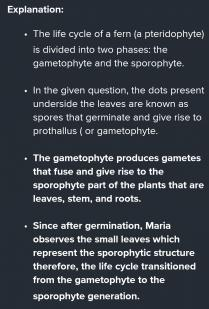
for six years an artificial fertilizer is used on a apple orchard the orchard is next to a stream which empties in to a slat water bay during the last 5 years researchers have observed an increase in algae in the bay they have also sampled fish populations in the bay each year apex...
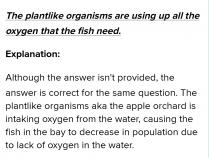
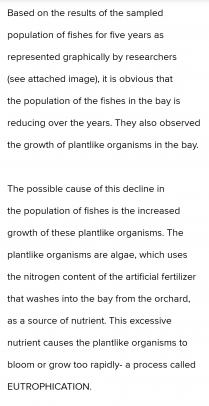
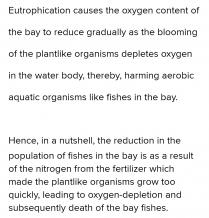
The maltose molecule can be broken down into two individual glucose molecules with the help of an enzyme produced within a cell.
D).increasing the pH with in the cell.
Explaination:
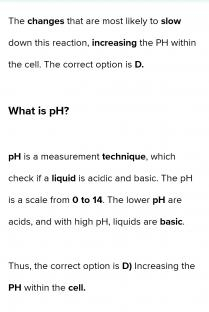
The T-chart by categorizing each statement as something that would most likely be relevant to gene flow or genetic drift. Some answers will fit in both columns depending on the situation. is random is a mechanism for evolution is often related to disasters is also called “migration” deals with movement between populations...
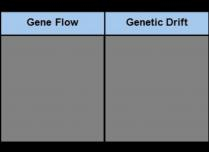
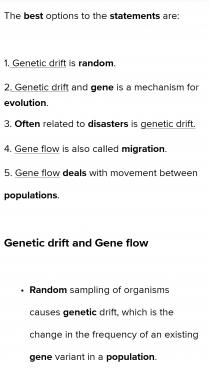

Angelica suffers from lupus disease.people with this disease are extremely sensitive to sun light.


It will provide an instant answer!
